|
Now it’s time to cover something that every teacher will just say, YES! One way to make schools better is to give teachers more time. Teachers are overrun with things they have to do, and it’s one of the only professions that does not really take into account planning time in the normal school day. Yes they get “a planning hour”, but the complexity of the teaching profession means there needs to be more there. Just like in the classroom, we need to create time out of thin air, and that can be really tough. There are ways though.
To understand what we need to do, we first need to understand the extras that teachers have to contend with. Most teachers' school days are full of teaching classes, and the time needs to be focused on their students. There is no time to plan, to organize, to grade, or do the other things that come with being in a classroom. The little time they get is either for a lunch break or for a planning time. Those times are usually taken though. They are either filled with professional development, team meetings, or just time to reset yourself. So, how do we give teachers more time? I think the first step is to make that planning period sacred and/or useful. We have to stop taking that from teachers. This should never be a time for meetings, pd, or anything else that takes them out of their normal flow. Team planning meetings can be here since they are actually planning. They just have to make sense and can’t be forced. I know for me, they always felt forced because I was trying to plan a creative classroom with mainly lecture based teachers. I truly believe I might have been better off without them. I have also known planning meetings that put teachers together who aren’t exactly alike in the class they teach. I have been in team meetings with AP teachers when I teach regular classes, and those curriculums aren’t technically the same. How is that helpful to either teacher? If the school day needs to be focused on the classroom, where do teachers actually have time they can spare for their own planning, professional development, and just general growth? It's summer. Yes, that’s weird to hear, but if we incentivise teachers to use the summer for more time, it can become an answer to our current overarching question. How do we incentivise summer? It’s going to take funding, and that’s always hard to come by. We need to increase the paid possibilities that teachers get during the summer that are instructional related. It could be professional development, lesson planning, or a host of other activities. Maybe this can be a place for community teams to step in and provide for teachers in that summer planning, or schools can find that money. Doing so gives teachers time during the year. I think the key here is to take off the teacher load. Anything you can do as an admin team member or school leader to remove that teacher load will help. You can incentivize them to help themselves or you can simply take off the extras. It’s all about being creative, so get creative with that time!
0 Comments
Oh, the next topic in how to improve US schools is a big one, but it’s also the one that has the least amount of good solutions. Have you figured out what I am talking about yet? It’s teacher pay. Teacher pay is some of the lowest out there, and it’s frankly one of the major reasons I moved the direction I did in my career. Is there even a way to fix it? The best answer is maybe, but it all starts with the ways schools are funded, and we all know when politics are involved it’s more of a crap-shoot.
School funding predominantly relies on property taxes. The original model is that local communities charge that fee, and then it in turn was pushed back into schools. Obviously, as schools have become more complex (with things like sports, technology, the arts, and more), the cost to run districts and local school buildings has skyrocketed with districts like Atlanta Public Schools pushing into the billion dollar budget range. Where does that extra money come from? It mostly comes from places like the state and the federal government and there are usually requirements attached. Sometimes those requirements then can be a hindrance to what actually happens in a classroom. Teacher salaries are usually an underlying part of the state funding and grant process. In most states, the state sets a base salary for teachers in the state that’s part of that process, and then the local school districts can add funds on top of that to increase those salaries as needed. A good example of this is in Atlanta, where Atlanta Public Schools actually pays some of the highest salaries in the metro as incentive to attract talent from the suburban districts. Treating salaries this way though causes a whole lot of disparity in the quality of teachers that is able to be attracted into a school district. Big metro districts can pull teachers from some of the surrounding suburbs because they can pay more, while rural districts almost always depend on community members becoming teachers because their vested interest in that community overcomes issues with the low salary. These community members are also the ones who understand the low salary can often carry you further because the cost of living is lower. So, in this complicated process, how do we give teachers more? I think almost everyone who understands public education realizes they need more (there are those who think the job is easy), but government money is always a tough thing to get. It also all starts with our favorite piece, politics. One of the first things we can do to increase teachers salaries is close loopholes. I know in the district that I live in that if you are of a certain advanced age you don’t even have to pay the property tax that trickles down to schools. If we truly take schools as community investments, it should be something that everyone contributes to. There are also loopholes where anyone can essentially transfer that tax receipt over to private schools. While I can understand why someone whose children are enrolled should be able to do this, allowing anyone to just take more money off the table that can be used to keep and retain public school teachers. Taking that public school money no matter what the loophole is should be one of the last things that ever happens, yet the trend seems to be to go the other way and have that increase. It is possible to also increase teaching salaries in creative ways. What if you went to the community and you said, “What skills do you want our kids to have?” Then you turn around in return and ask the community to contribute to teaching salaries. Could you get enough for a nice increase? Many teachers also are taking extra jobs to make ends meet. What if we did that in an organized way, and made that salary worth it? Could you have teachers staff a store, event or something else that isn’t taxing, but could give them that extra income they need? I am sure there are hundreds of other creative ideas out there, and I would love to hear some others. The key is that teacher salary has to change. Teachers aren’t paid enough, and I think that is incredibly clear. To change that issue though, we have to rethink funding, and that’s the hard part. Hopefully, we can get creative, but we can also get the politics to work. What’s the common characteristic of most schools that are deemed failing? It’s that they exist in a rough community. Many of the problems that the school has are ones that can carry over from the community including fights, drugs, gangs, and more. It means that failing schools aren’t just school issues, they are community issues. Since schools are community issues, we have to find ways to make that community strategic partners. Doing that will help bring about the needed change.
To start this process in the community, I think you first need to look at what your community needs. Do they need teachers? Computer Programmers? Something related to a business in the area? If you have that need front and center you can then tweak what happens in your school (especially at the high school level) to fill that need. You can add pre-teaching classes and programs. You can add the AP CS classes. Those classes will prepare students who have a vested interest in the community for the jobs that really matter in them. Just think about one of the biggest issues in failing schools. It’s easily teacher retention, and I got to see it first hand when I was technology coach. During that time, I was assigned to what many would consider one of the worst schools in the city of Atlanta. I did not know what to expect, but to my surprise there was an amazing group of teachers in the building. The issue though was that the group was small. Many times teachers left this building in the middle of the year simply because they could not handle the student population. You know who would be better positioned to handle them? People who grew up there. People who had a vested interest. If this school could ever get a pre-teaching program started, they may actually have a chance to build a staff that really worked for the tough area they are in. Community involvement can also be other things. I have seen schools have incredible luck with internships, and so many communities have been generous in donating and giving items to schools. I have also seen things like professional sports teams sponsoring STEM activities. The key with all of it is can you creatively find an academic purpose for the community to be involved in that is mutually beneficial. If you can, run with it! I think there is still some hesitancy to get these programs going in many schools because of the safety concerns that come within opening your building to the outside, but if we lock schools down students are never going to get the full benefit. We have to find ways to make it work. It’s too important to have people that have that investment into making the community a better place. Let’s move on to the next piece in fixing US education, and it’s one that may seem counter-intuitive. It’s decreasing the scope of standards in many classes! Yes, that means, let’s teach students just a little less content, but before you judge, let me tell you why. This also does not necessarily apply to every subject area as I have seen some (like some ELA standards) that are more focused on specific skills rather than content.
I think for me, this change all starts with my experiences teaching history. I taught both world history and US history courses for years, and let’s just say those standards are a whole lot. In US, we had to teach the entire history of the US before the standardized test, and it included every reform movement you can think of because the politics of a civics class dictate that. In world, we had to teach the entire history of the world in a year, and the timeline jumped from continent to continent which made continuity almost impossible. Thankfully, the world did not have a standardized test. Each class had way too much content, and it made things challenging. The question with these intense standards is “Why?” Why do we include content at the K-12 level that is really only a need for students who are entering that field of study in college and beyond. Why do we include those content pieces that most students forget before the end of the year is out? It’s one thing to teach content that is a building block for a greater understanding of the world, but it’s another thing to overfill standards with too much content making it impossible for students to get the experiences that make school fun and time to practice skills that will actually carry them forward. If we continue to give teachers such intense standards, they focus on the content delivery aspect almost exclusively. If states were to take their standards and cut them down to just the necessary content, it would leave time for teachers to have students write, create, act, and practice future ready skills. They could gain deeper understanding of the content they were studying, and students could actually have fun in school! It also makes the state test at the end of the year less stressful for them. A shrinking of standards though, may help the teachers even more. If you are in one of the classes where the standards are packed tightly, lessening the standards immediately takes some of the pressure off. Those classes are a race to get all of the content in before the test, and so that race of content delivery is understandable. That race means you have to either get creative with your scheduling, or your class is almost all content delivery, or you simply don’t finish the content. All of those choices aren’t perfect, so maybe by lessening the standards impact you can give teachers the time they need to push student learning the right way. Now is this an easy process? No, it takes the state to make it work, and those politics always get in the way. Hopefully, someday we can lessen that political impact, but in today's world it looks like it may just be increasing. It means it’s time to advocate and make our educator voices heard. Call your state legislators and school boards to make this a priority! Part 2 of my summer series, “How can we fix US schools?” is here, and this time I want to focus on one of the things that is on everyone’s mind, safety. With the events that ended the school year and the seemingly endless parade of school shootings, it seems like something that will never be very far from the conversation. It also doesn’t seem like real actionable steps from the government will address it anytime soon. Like most things, schools are going to need to get creative.
The key question here is, “How do we provide a secure safe learning environment, without making schools fortresses and wasting millions of dollars on it?” Inherently, that’s a tough question to answer because you are toeing a fine line. We have to do everything we can to protect students, but we also want these environments to be open community centers where children can grow and play while parents participate in those proceedings. There is also no room for error when it comes to funding. We can’t pour tax dollars into security measures that may or may not work while the instructional environment is already suffering. Before we get into what I think may help here, let’s dispel some notions that most certainly will not. Things like arming teachers, fencing, armed security guards, and only one door in and out are not solutions. In fact, most would cause additional issues. Let’s start with arming teachers. Almost to a person, I have not seen any teacher support this notion. They know the reality of it, and that reality is incredibly dark. In most cases, school shooters have been or are students in the school they are attacking. By arming that teacher, you are asking them to take the life of that student in an instant. That is a terrible choice, and I would think many will get harmed in the process of trying to talk that student down. Any teacher worth their salt also knows the training for this would be terrible. The money just would not be there to make it long enough and worthwhile enough. Finally, almost every teacher has set down their keys, glasses, coffee cups in places in the school building and had to find them. What happens when that is a firearm? I think the other things that are brought up are at best putting a band-aid on a bigger issue. While some fencing could help, you also want schools to be a place of community, and that fencing could quickly go overboard. I know the feeling I get seeing barbed wire schools in other countries, and I don’t want to see that here. Armed security / police in a school have seemed to help in some instances, but they can also be very negative. John Oliver did a great piece on Last Week Tonight that you can find HERE on the negative impact that school police can bring. With that being said, I do think school police officers need to be there (I have known some great ones), but that process needs to be thought through. Last, but certainly not least, the one door in and out theory (as expressed by Ted Cruz), is just unrealistic. We want kids to be outside, playing, having fun, and doing recess. They need that movement. We just need to figure out how to make it secure. So, what can we do? Seeing many schools over the years, I think it needs to be a combination of a student centered and technologically driven approach. The student centered piece needs to be more important, and it needs to start with a focus on anti-bullying efforts and counseling. We need to try and reach students who may turn violent before it starts, and showing them effort and love may get us there. When you look at the whole of individuals committing school violence, what are the common themes? They are bullied. They feel alone. They are angry. We have to try and lower those temperatures before they even start, and there are things we can do to do it. We could make a renewed push into preventing bullying, and change the way we discipline students who are caught doing it. What if we made them do an act of kindness in those instances? What if we tried to get to the heart of the matter of why they are bullying? Could we stop things in their tracks? A renewed focus on mental health is of course needed to. The problem with it now in schools is that many counselors don’t even have time to focus on it. When you think about counselors at the high school level, what do most of them do? They do college admissions. What if we split that off into separate roles and had counselors who could actually focus on mental health? It might make a world of difference. There would also need to be a renewed focus for them on how to deal with those issues, but just freeing them up is a great start. From the technological way to keep folks safe, it is all going to boil down to money. Changing this kind of infrastructure takes it and are lawmakers willing to do it. While I am no expert in the field, could simple finger print oriented locks help? Many colleges use them to restrict access to things like athletic facilities, so I would imagine it may be possible. If staff can be part of those locks easily, they could come and go from the building with ease and never have to prop doors or mistakenly leave one unlocked. I think most teachers would gladly trade putting their finger down coming in from recess over messing with their keys. Doors could even be programmed to unlock at certain times to enhance school movement (Many high schools are structured with outside movement), and then lock as soon as that movement is over. You could even program in different access for school events which gives schools an even better approach on what is going on in their classroom. Another simple tech idea to help is adding an alarm bell to doors that are not supposed to be open during the day. This sounds really annoying, but hear me out. If there is an alarm, teachers in that area know that the door is likely open, and they would be highly motivated to turn off that annoying sound. It doesn’t have to be something incredibly loud, just more a reminder to close up that door. You could even get more fancy with the technology side of it as well. I have no idea how much they cost, but what if even just high schools added the security scanners that places like Disney and Six Flags have? I am talking about the ones where you just walk through and then they pull you out of line. While not perfect (Disney still does bag searches), they are less intrusive than a metal detector. You also almost forget it’s there unless you are stopped, so it takes that fortress level down. I am sure there are hundreds and thousands of other solutions out there, but hopefully lawmakers at some point can take even more additional steps. I think the key here is we have to remember how this additional security and safety affects students. If it affects them negatively, it’s probably not a good solution. |
Archives
January 2023
Categories |
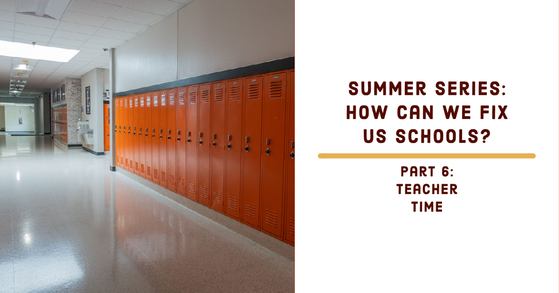
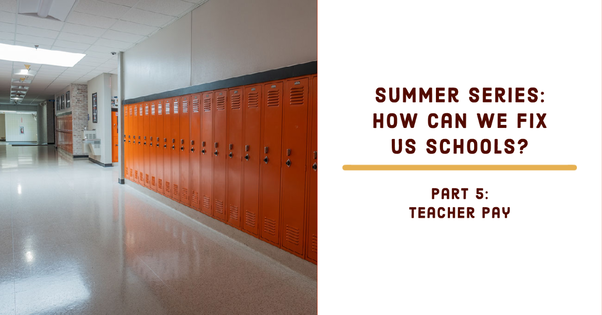
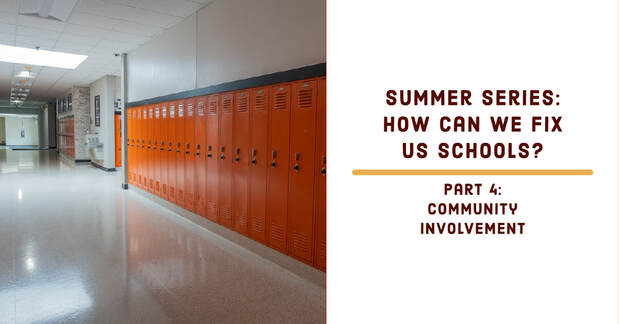
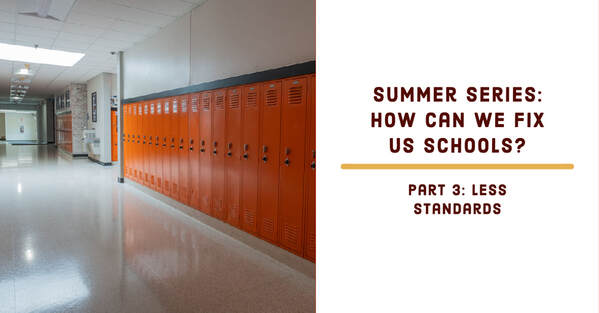
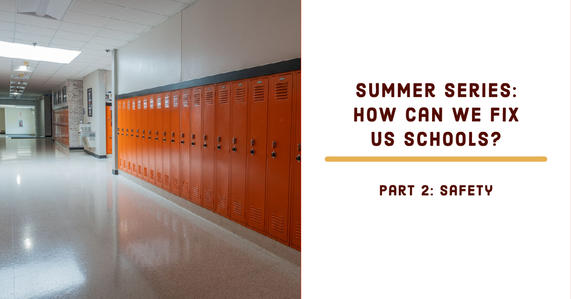
 RSS Feed
RSS Feed
